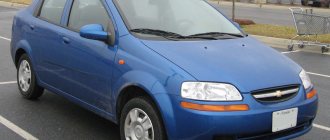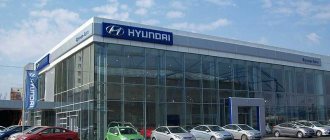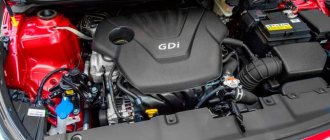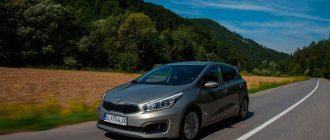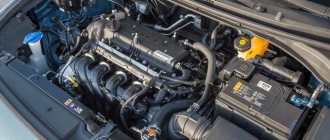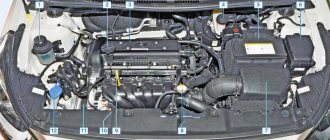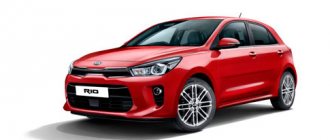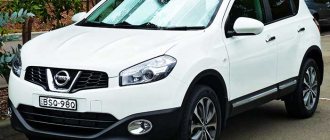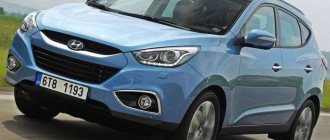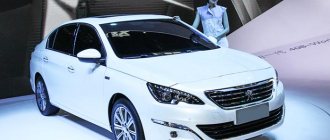New products
The Russian plant is constantly striving to develop, so this company recently offered about five options for different car models.
Hyundai Solaris has become the fourth generation of Accent, popular among Russian car enthusiasts. The name of the third generation, known to Russians as “Verna”, was remembered and went down in history as an unsuccessful project. Nowadays such a car is almost impossible to find. The reason for the failure is errors in the miscalculation of marketers. The car turned out to be too expensive. Therefore, production of “Verna” has been discontinued in Russia. Chinese Solaris manufacturers began calling their cars Hyundai Verna. They have this vehicle equipped with red interior lighting, slightly modified interior elements and a colored front bumper and headlights.
HMMR is one of the largest automobile manufacturers in Russia, producing 200,000 vehicles per year. The plant is equipped with modern industrial automation equipment, including 185 robots, and has created about 7,000 jobs in the region. The St. Petersburg plant achieved 46% localization with the cooperation of local suppliers.
In which countries and where is Hyundai Santa Fe assembled, factories in Russia
Popular reviews of the new Hyundai solaris with photos
The Hyundai Santa Fe is a well-known crossover, which today is considered almost the best alternative to Tussan.
Solid appearance, rich “filling” and good driving performance made this model popular in the world.
Car production began in 2000, seven years later the second generation Santa Fe appeared, and in 2012 the third.
Today the car is produced in the USA and South Korea, from which, in fact, the cars come to Russia.
It is interesting that the first and second generation Hyundai Santa Fe were assembled in the Russian Federation (at TAGAZ).
For some time after 2009, the 1st generation Hyundai Santa Fe could only be found in Taganrog assembly.
The reason was the fact that sales of first-generation cars were stopped in South Korea and production of the second began.
Where is Hyundai Elantra assembled for Russian consumers?
Hyundai Elantra is a mid-size car that has been produced since 1990. It received its last generation update in early May 2010. Since then, engineers have carried out one restyling, which made the car even more powerful and more aesthetically pleasing than it was before.
In Russia the car sells quite well. In its class, it has won the trust and love of consumers. We wondered if it really is as perfect as its owners describe it. And, as you know, the quality of a car depends on where the model is made. Therefore, let’s figure out where the Hyundai Elantra is assembled and how it is produced.
Countries where Hyundai cars are assembled
In general, the South Korean company Hyundai has quite a lot of factories around the world. The concern's engineers ensured that their models became recognizable and popular. Production is located on all continents of the world where Korean cars are sold. That is why the corporation demonstrates such huge sales. But, most likely, the popularity of cars is influenced by the quality of the build, and not the number of factories.
Naturally, the first plant we will talk about is located in South Korea. Hyundai Elantra is assembled here in the town of Ulsan. The plant makes approximately two-thirds of the total volume produced by the company for the year. Some of the cars remain on the domestic market, but most are sent abroad.
Hyundai Elantra is also produced in Turkey. The Hyundai factory in this country opened in 1998. It was the first enterprise that enterprising Koreans designed outside their own country. Today, one of the most powerful factories with huge production volumes is located here.
Until 2010, Elantra was assembled at the TAGAZ plant in Taganrog. As you already understand, we are talking about production in Russia. But now the models are produced at Hyundai's own plant. It is called “Hyundai Motors Manufacturing Rus” and is located in St. Petersburg.
It is also worth mentioning factories in America, Brazil, China, India and the Czech Republic. But, these productions make Hyundai Elantra for the world market. They don't go to Russia. Therefore, we will leave the disassembly of their assembly to the Europeans and Americans, and we ourselves will understand the work of the engineers of those countries where this model is assembled for Russia.
Characteristics of Russian-assembled Hyundai Elantra
The assembly of a model always depends on who is assembling it. As mentioned above, the Hyundai Elantra has been in production since 1990. At that distant time, the car was delivered to us by sea from the plant in Ulsan. The South Korean assembly caused virtually no complaints. Now in Russian car dealerships you can find approximately 60% of cars of this production. The rest of the cars were assembled here, first at the plant in Taganrog, and now in St. Petersburg.
In any case, the Hyundai Elantra appeared a year later than on the world market. But, on the one hand, this is very good. After all, it is in the first year of operation that all the visible shortcomings of the model appear.
Our engineers assemble the car according to all international standards, slightly adapting it to Russian roads. For example, they installed heated seats, a warm steering wheel and slightly increased the ground clearance. It rains all year round in Korea. Thus, engineers installed excellent rain sensors and glass on the car, from which water quickly drains. Russian engineers did the same. Only this feature suits us better for snow.
In general, there are no comments about the chassis, appearance, or technical characteristics of the Russian-assembled Hyundai Elantra. Therefore, when purchasing this machine, you do not have to worry about its quality.
General information about Hyundai Motor
Hyundai solaris 1.6 with automatic transmission
Hyundai Motor Company is a South Korean automobile manufacturer with a wide range of models and is widely known in the world.
The founder of the concern is considered to be Chung Ju-Yong. It was he who opened the company in 1967, which was initially only part of a large project, and in 2003 became an individual unit.
Initially, Hyundai Motor focused on passenger cars, but also produced one Ford truck.
Over the next thirty years, the company developed and expanded its production scope. Five years after the opening, the production of Hyundai cars began, and two years later the Hyundai Poini model appeared.
By the 80s of the last century, production volume reached 50 thousand cars per year. In 1998, a significant event occurred in the history of the company - Kia Motros was absorbed.
The name Hyundai is translated from Korean as “modernity.” In fact, this word became the motto for manufacturers, who tried to embody new trends and trends in each model.
In which countries and where is Hyundai IX35 assembled, factories in Russia
Reviews from Hyundai Solaris 2015 hatchback owners
Hyundai IX35 is considered one of the most popular crossovers in Russia. Sales of the car first started in 2009, and the first deliveries began a year later.
The first generation Hyundai IX35 was assembled in three countries - the Czech Republic, South Korea and Slovakia. At the same time, cars from each of the listed markets ended up in Russia.
In addition to these countries, the Hyundai IX 35 was also assembled in China, but here production was aimed more at the domestic market.
The car is not yet manufactured in Russia, so domestic car enthusiasts have to be content with cars from the Czech Republic.
Taken as a whole, the situation looks like this:
- South Korea and China - for the domestic market;
- USA - for South America, Canada and the United States;
- Czech Republic and Slovakia - for Europe.
The exact location of the plant can be calculated using the VIN code:
- L - Slovakia (Zilina);
- J - Czech Republic (Nosovice);
- U - Korea (Ul-San).
Owners of Korean-assembled cars claim that the plastic in the car is softer.
As for the Hyundai IX35 from Slovakia, many complain about a large number of shortcomings in the body part.
In which country is Hyundai Solaris assembled?
Not all Russian car enthusiasts are ready to spend exorbitant amounts of money to buy a car. Many people choose relatively inexpensive options. For example, Hyundai Solaris. The cost of the car is low, and the quality is excellent. You can buy a car not only new, but also used. In this case, his condition will be very good. The same cannot be said about many other cars in this segment.
The car's name contains its description. Solaris is translated as modernity. And indeed the car combines everything that drivers need today - comfort, reliability and safety. The place of assembly plays an important role in determining the quality of the model.
General information about Hyundai Motor
Hyundai Motor Company is a South Korean automobile manufacturer with a wide range of models and is widely known in the world.
The founder of the concern is considered to be Chung Ju-Yong. It was he who opened the company in 1967, which was initially only part of a large project, and in 2003 became an individual unit.
Initially, Hyundai Motor focused on passenger cars, but also produced one Ford truck.
Over the next thirty years, the company developed and expanded its production scope. Five years after the opening, the production of Hyundai cars began, and two years later the Hyundai Poini model appeared.
By the 80s of the last century, production volume reached 50 thousand cars per year. In 1998, a significant event occurred in the history of the company - Kia Motros was absorbed.
The name Hyundai is translated from Korean as “modernity.” In fact, this word became the motto for manufacturers, who tried to embody new trends and trends in each model.
Hyundai Motor Corporation
Having found out where the Hyundai Solaris is assembled, you can move on to the manufacturer’s description. This is a company from South Korea, which is widely known for its model range that has earned popularity all over the world.
The founding date of the concern was 1967, when the enterprise was successfully opened thanks to the efforts of Chung Ju-Yong. Until 2000, this was only a link in a large project. But later the situation completely changed and Hyundai Motor became a separate enterprise.
At the beginning of its activity, the plant produced passenger cars, but soon freight transport saw the light of day - a Ford truck rolled off the Hyundai Motor assembly line.
To successfully increase production volumes, the company needed additional capacity. Then the idea arose to open a plant in Russian St. Petersburg. For more than five years now, this enterprise has become the place where Hyundai Solaris is assembled.
Russian specialists working for Hyundai Motor are characterized by a responsible attitude to work and strict adherence to deadlines for delivery of the finished product. For the successful operation of the St. Petersburg plant, the Koreans invested more than half a billion dollars in this project.
The plant in Russia, where the Hyundai Solaris is assembled, is an enterprise designed to carry out the entire process of creating a vehicle within one state. Here, parts and components are manufactured, welded, assembled and painted.
Thanks to the presence of a stamping shop, all stages of production can be successfully completed within one enterprise.
Also, the factories where Hyundai Solaris (2013) is assembled are the following enterprises:
- Indian;
- Turkish;
- Czech;
- American
General information about Hyundai Motor
Hyundai Motor Company is a South Korean automobile manufacturer with a wide range of models and is widely known in the world.
The founder of the concern is considered to be Chung Ju-Yong. It was he who opened the company in 1967, which was initially only part of a large project, and in 2003 became an individual unit.
Initially, Hyundai Motor focused on passenger cars, but also produced one Ford truck.
Over the next thirty years, the company developed and expanded its production scope. Five years after the opening, the production of Hyundai cars began, and two years later the Hyundai Poini model appeared.
By the 80s of the last century, production volume reached 50 thousand cars per year. In 1998, a significant event occurred in the history of the company - Kia Motros was absorbed.
The name Hyundai is translated from Korean as “modernity.” In fact, this word became the motto for manufacturers, who tried to embody new trends and trends in each model.
Where is Hyundai Solaris assembled for Russia and other countries?
In today's article we will talk in more detail about the Hyundai Solaris model, as well as where and how it is assembled.
An interesting fact is that if the first generation of Solaris was assembled exclusively abroad, then the second generation is already produced in Russia.
World famous Hyundai factories
- It is not surprising that the most powerful plant is located in the South Korean city of Ulsan. Cars of this assembly are sent for sale mainly to the Asian and European markets.
- A plant in St. Petersburg that produces cars for the domestic market and CIS countries.
- The plant in Turkey, which began operating in 1998, is the second in capacity after the Korean one. It produces cars for sale on the European market and in the Middle East.
- There is another Russian Hyundai plant, which is located in Taganrog. But at the moment, the second generation Solaris is not built on it.
- We should not forget about factories in India, the USA, Brazil and, of course, China, but the cars produced there are not supplied to the Russian market.
Photo: Hyundai plant in Russia
It is worth noting that the Solaris model is annually included in the top five best cars in Russia, and the fact that it is assembled exclusively by domestic specialists is very pleasant.
However, as they say: “The first pancake is always lumpy.” The debut models assembled at the plant in St. Petersburg had a lot of shortcomings. First of all, these are problems with the transmission, which often failed. Also, the suspension was not very reliable. But through trial and error, the developers eliminated the problems, and soon serial production of Solaris successfully started at the plant.
I am pleased with the level of quality control at the plant, because there are always several Korean specialists here who constantly monitor the progress of production.
Is it worth buying a domestically assembled Hyundai Solaris?
The main reason is the high quality of domestically assembled Solaris models.
Such results can be achieved due to round-the-clock work, because the working day is divided into three shifts. Therefore, the conveyor practically does not stop.
As mentioned above, quality control is carried out exclusively by Korean specialists, who approve or send products for revision.
The St. Petersburg Hyundai plant is one of the largest branches of the Korean company. Hyundai Solaris cars, which are assembled on it, are among the highest quality and most popular models on the domestic market. Therefore, if you decide to purchase a Russian-made Solaris, you can be completely confident in good build quality.
Where is Hyundai Creta/Greta assembled in Russia
Hyundai Creta is a small crossover that was introduced to a mass audience in 2014, and in 2021 it appeared on the domestic market.
Most car enthusiasts are interested in where the car they want to buy is made. They study news sources and information on the automaker's website in order to know everything.
A little about Hyundai Creta
Hyundai Creta immediately acquired a large number of competitors, including such famous crossovers as Renault Kaptur and Kia Soul. Despite this, Creta quickly gained popularity and began to confidently conquer its market niche, where it subsequently gained a foothold.
Huyndai, unlike its competitors, did not reinvent the wheel and experiment with the exterior. They placed the car on a very strong platform, equipping it with a strict body, in the “face” of which the signature features of the manufacturer are easily discernible: a radiator grille and headlights.
The car is equally in demand both in the Asian and European markets. Hyundai Creta pleases with a wide range of different power units. There are four of them - two petrol and two diesel.
Crossover assembly
Even before the plant began producing cars, the manufacturer received a record number of pre-orders - more than 70 thousand. The Chinese version is sold under the name ix25. Chinese and Indian models are not very different from those produced for Russia.
In the summer of 2021, the manufacturer decided to assemble cars in our country. For this, they began to use the Hyundai plant located in St. Petersburg. From the first day of production, Hyundai Creta crossovers began to go on sale at dealerships.
- established technologies allow you to avoid spending money on reconstruction;
- a car produced in Russia will cost less due to reduced production costs;
- no additional training of plant personnel is required;
New products
The Russian plant is constantly striving to develop, so this company recently offered about five options for different car models. Hyundai Solaris has become the fourth generation of Accent, popular among Russian car enthusiasts. The name of the third generation, known to Russians as “Verna”, was remembered and went down in history as an unsuccessful project. Nowadays such a car is almost impossible to find. The reason for the failure is errors in the miscalculation of marketers. The car turned out to be too expensive. Therefore, production of “Verna” has been discontinued in Russia.
Chinese Solaris manufacturers began calling their cars Hyundai Verna. They have this vehicle equipped with red interior lighting, slightly modified interior elements and a colored front bumper and headlights.
HMMR is one of the largest automobile manufacturers in Russia, producing 200,000 vehicles per year. The plant is equipped with modern industrial automation equipment, including 185 robots, and has created about 7,000 jobs in the region. The St. Petersburg plant achieved 46% localization with the cooperation of local suppliers.
Production of Hyundai Solaris in Russia
Photo: Hyundai plant in Russia
The Hyundai St. Petersburg plant began construction in 2008. The launch of production took place in 2010, and at the moment the plant produces 80% of the cars in the Russian automobile industry.
It is worth noting that the Solaris model is annually included in the top five best cars in Russia, and the fact that it is assembled exclusively by domestic specialists is very pleasant.
At first it was expected that only body production would be carried out at the St. Petersburg plant, but later it was decided to entrust the local workers with the complete assembly of the car. Interestingly, during the production of Hyundai Solaris, assembly is carried out almost manually, with minimal use of robotic technology. These methods are practically no longer used in factories in other countries.
However, as they say: “The first pancake is always lumpy.” The debut models assembled at the plant in St. Petersburg had a lot of shortcomings. First of all, these are problems with the transmission, which often failed. Also, the suspension was not very reliable. But through trial and error, the developers eliminated the problems, and soon serial production of Solaris successfully started at the plant.
Korean investors have invested over $500,000,000 in the St. Petersburg plant, which makes it the largest and most modern in the CIS.
I am pleased with the level of quality control at the plant, because there are always several Korean specialists here who constantly monitor the progress of production.
ALSO SEE: Technical specifications of Hyundai Solaris 2019
Photo: Hyundai Solaris at a plant in Russia
Production of Hyundai Creta in Russia
Production of the Hyundai Creta in Russia began in 2021. Initially, the plant was adapted for the assembly of Kia Rio and Hyundai Solaris. To produce the Creta, a completely new assembly line had to be assembled. For this purpose, new equipment was installed - more than 50 robotic machines, which required minimal human participation in production.
The Hyundai Creta produced in Russia has a number of differences, since we still had to adapt the model to our local realities.
Firstly, the car has increased ground clearance and reinforced suspension. This was done for our “good” roads, since this crossover will most often be used on roads of poor quality.
Secondly, the car has only engine versions in the line - petrol 1.6 and 2.0 liters. They decided not to use diesel, since our people have a clear dislike for modern diesel engines. And this could have a negative impact on car sales.
Thirdly, two types of drive are available for the car - front-wheel drive and all-wheel drive, from which the buyer can choose when purchasing a car.
Hyundai production plant
The Hyundai Motor Company plant is located near St. Petersburg, Russia. Another popular car is assembled here - the Kia Rio, which is almost identical to the Hyundai in technical terms. Only the interior design and exterior are considered distinctive features. Another country where Hyundai Solaris is assembled is South Korea. But there this vehicle has a different name - Verna or Accent.
The production of the Hyundai concern really lives up to its name, which translates as “modernity”.
Cars are assembled in many countries and on different continents. For the Russian market, Hyundai Solaris is produced in:
- South Korea. The plant is located in Ulsan. This is the company's most powerful and largest assembly shop;
- Russia. Production is established in St. Petersburg;
- Turkey. The plant opened in 1998. This is the second most powerful enterprise after the Korean one;
- until 2010, cars were assembled in Taganrog, but now the conveyor belt for the above-mentioned model is closed;
- Also, there are factories in India, the Czech Republic, America, Brazil and China. But cars are not supplied to Russia from there.
Test drives
We looked again at how Hyundai Solaris is assembled
Elena Kostrikina, October 15, 2015
Three years ago we already visited the Hyundai plant in St. Petersburg, where the bestsellers of the Russian car market - Hyundai Solaris and Kia Rio - are assembled. Then the press tour took place in anticipation of the sale of the 200,000th Solaris. This fall, the time has come for a new “inspection,” especially since the reason is serious—the millionth car coming off the assembly line.
Let us remind you: in St. Petersburg, the full cycle of Solaris and Rio is produced - each in sedan and hatchback bodies. However, the main demand (80%) in the case of both models is for the sedan. Therefore, with the change of generations, the five-door will disappear, and its niche will be occupied by a new subcompact crossover. Hyundai will call it Creta, and its production in the Russian Federation is planned to begin next fall. Kia will also have an alternative SUV. The current capacity of the plant provides for the assembly of four models, so crossovers will simply replace hatchbacks on the assembly line.
| Stamping shop. Here the metal is transformed into body elements |
The plant includes four workshops: stamping, welding, painting and assembly. We were allowed into everything except the painting shop. In the stamping shop, mechanical presses form side panels, hoods, doors and other body parts. You already know how this happens from the previous report.
| Finished and tested parts awaiting further fate |
In the welding shop, processes are as robotic as possible. The robots, by the way, are also from Hyundai. The hard work and efficiency of these “employees” is admirable; you can watch the process endlessly.
| The screen clearly displays the process of joining parts |
The assembly shop is already much more crowded. Here the cars acquire their full appearance and content and are sent for test tests.
| At the exit from the welding shop, these “blanks” appear. Coloring ahead |
The conveyor is a place with perfect order in everything, including time. The working day of an employee engaged in production is as follows: 2 hours of work, a 10-minute break, another 2 hours of work, a 40-minute lunch break, and then two more “sessions” of 2 hours and 10 minutes.
| Car assembly: engine compartment “witchcraft” |
In general, the impression was that people liked their work, that they realized that they were involved in an important process, the results of which would please many people. By the way, Hyundai Solaris has already become the best-selling car in Russia several times, ahead of the more affordable domestic budget car LADA Granta. This happened, for example, in September, when the “Korean” broke its own sales record for the month, showing a result of over 11 thousand cars. The Rio, which sold 10,822 cars, was just a little behind it.
| Despite the difficult conditions prevailing in the Russian car market, the plant continues to operate 24 hours a day in three shifts. It takes less than one and a half minutes to produce one car |
Korean “state employees” are in great demand not only among private buyers, but also in commercial and government projects: in January-August of this year, Solaris and Rio are leaders in corporate sales among mass models of the Russian market, with a total share of 42%. As an example, let’s take the Moscow car sharing project “Delimobil”, to which Hyundai will gradually provide a total of 1.5 thousand Solaris.
In less than 5 years since the start of production, Hyundai Solaris and Kia Rio have repeatedly received various improvements, and not so long ago they underwent a full restyling: Solaris last year, and Rio this year. The release of new generation models is just around the corner: for example, a completely new Solaris will appear at the end of 2021 - beginning of 2021 and, as we mentioned earlier, only in the form of a sedan. Details, of course, are kept secret for now, but the management of the Russian office of Hyundai noted that the car will have a more European design.
Should I buy a Hyundai Solaris of our assembly?
As you already understand, all Hyundai Solaris on our roads are assembled in Russia. Of course, you can bring a car from abroad. But, as practice shows, buyers do not do this. Let's look at what this is connected with below.
The productivity of our plant in St. Petersburg is 200,000 units per year. Today this enterprise is the largest foreign one in our country. It has a full assembly cycle, and its workshops operate around the clock. Everything here is organized in three shifts. That is, the conveyor almost never stops. The company employs about 2,000 employees who replace each other. Workers receive excellent benefits and good wages. Therefore, working conditions can be compared to European ones. Koreans recruit mostly young employees. There is automated production here, which is supplemented by human labor. Quality control of assembled cars is carried out only by Korean specialists. They check the models for tightness and strength. This gives confidence in the quality and reliability of the machines. Therefore, if you decide to buy a Hyundai Solaris, then don’t let our assembly stop you.
This is how Hyundai Solaris is assembled
Hyundai Motor Manufacturing Rus LLC is one of the largest assembly sites and the first full-cycle foreign automobile plant in Russia. Today, the plant assembles side by side two models of two brands that are part of a single alliance - these are Kia Rio and Hyundai Solaris. Total production capacity is 200,000 cars per year. What is hidden behind these dry statistical figures?
First of all, of course, the team of employees. The plant, which the Koreans built from scratch, virtually in an open field, provided jobs to more than two thousand people. Most of them are residents of St. Petersburg and the Leningrad region, who work at the plant in three shifts: in April 2012, the plant reached full capacity and has since been working around the clock. Moreover, the working conditions can be called attractive: an eight-hour working day, a minimum guaranteed salary of 36,000 rubles with regular indexation and a full range of social guarantees. And most importantly, Hyundai welcomes young professionals: the average age of assembly line workers is 26-28 years.
| In the best traditions of the Soviet past, banners with slogans are hung throughout the Hyundai plant. |
Of course, the monotonous work that you do day after day, month after month, year after year can hardly be called the ultimate dream. It requires a certain patience and character. For example, I wouldn’t be able to stand it for long. And yet it is work. Stable and well paid. For our sometimes unpredictable life, this is already a good foundation for building our future.
| To prevent monotonous work on the assembly line from turning people into robots, assemblers change responsibilities every two hours - a common world practice. |
But at the Hyundai plant there are two workshops where such castling is not required - the body welding and painting line is fully automated. There are no people here at all, except for the person responsible for turning the robotic arms on and off. And this, by the way, is an indirect sign that there is no need to worry, at a minimum, about the quality of welding and painting of Solaris. In general, watching how, two meters from you, the revived mechanisms themselves take body panels, put them on stocks, weld them and pass them on to their “colleagues” is a fascinating sight. Reminds me of a scene from the movie "Terminator".
By the way, all the robots at the plant are also from Hyundai, as well as the buses that transport employees, and the trucks that transport materials or spare parts. After all, the Korean concern includes seven divisions involved in the development and production of not only cars and engines, but also industrial equipment, electronic systems and even shipbuilding.
To minimize logistics costs, satellite enterprises producing spare parts and components were built next to the production and assembly workshops. The largest of them is Mobis. It is here, for example, that bumpers for the Hyundai Solaris are cast, as well as the entire front panel, which is finally assembled in a nearby workshop.
| An interesting observation: the radio for the Kia Rio (left) is made in China, and for the Hyundai Solaris (right) is made in Korea. By the way, on the assembly line, two cars are mixed together along one assembly line. The same situation applies to the assembly of their components. |
At the final stage of assembly, all cars are sent to the control line, where they are started for the first time and undergo full quality control. One such test is the “shower room”, in which machines are tested for leaks. By the way, the phrase “quality control,” which a year ago the managers of GM AvtoVAZ repeated like a mantra in every sentence, was heard by journalists only a few times during the day of the tour of the Hyundai production site. Another sign that Koreans are confident in the reliability of the product they offer to customers. And record sales of Solaris confirm this. It’s not for nothing that the executive director of Hyundai Motor Manufacturing Rus, Mr. Kim Shi Pyong, who accompanied us throughout the day, walked with a contented look and his head held high...
Salon
It looks quite expensive and prestigious. The interior equipment of a Korean-assembled car is made of expensive and high-quality materials: soft genuine leather, environmentally friendly plastic, wear-resistant fabric.
Management and control systems
The center console has a multimedia system with a touch screen, air ducts, traditional controls in the form of buttons and washers, as well as a fairly spacious glove compartment.
The tunnel is equipped with standard elements, several chassis adjustment buttons, cup holders, space for a smartphone and other gadgets. Volumetric armrest for added comfort and multiple movement switches.
The steering wheel has become larger in girth and more functional. The massive central section houses a variety of switches that can be used to control most of the vehicle's functions. The steering wheel is covered with anti-slip braid, made of high-quality leather. The dashboard is of a standard type, with an on-board computer in the center.
Seating
Judging by the photo of the interior, its appearance has become quite respectable thanks to the seats. High-quality upholstery material and elastic filling, lateral support and heating, adjustment in a wide range - everything is done for your comfort, and an abundance of safety systems will protect all car passengers on the road.
The salon is neat and spacious. When fully seated in the car, no person, no matter what size it is, will feel constrained. At the exhibition of the new model, the manufacturer assured complete sound insulation in the cabin.
In which countries and where is Hyundai Elantra assembled, factories in Russia
The Hyundai Elantra model is well known to Russian car enthusiasts. The car belongs to the C-class, and in its segment it rightfully occupies a leading position.
The first model came off the assembly line back in 1990, so we can talk about the model being quite old. By the way, Elantra is also known under other names - Avante and Lantra.
There is often a question online regarding the production of the Hyundai Elantra.
It is not always clear where the car is assembled, because the last update of the model was seven years ago (in 2010). By the way, from that moment on, no significant changes were made - only the appearance was adjusted.
For some period, Elantra was assembled for the Russian Federation and Europe in the Czech Republic (in the city of Nosovica).
The car was also produced in St. Petersburg. In 2009, assembly of the “South Korean” was established in Ukraine, at the Bogdan plant. At the same time, the main supplier still remains South Korea (Ulsan).
It is from there that the car is sent to many countries, including Russia. By the way, in the period from 2000-2007, Elantra was produced in Taganrog (“Tagaz”).
In addition to those already listed above, Elantra factories are located in Turkey, the Czech Republic, China, Brazil and India. But the main supplier for Russia (with rare exceptions) is South Korea.
Where is Hyundai Solaris assembled, features of Hyundai Solaris production
Solaris is a compact car created by Hyundai Motors, a South Korean company.
In 2010, the plant in St. Petersburg learned that they wanted to start producing a Verna version of the car. The car was presented on September 21 of the same year, and the Russian name for this car, “Solaris,” was immediately introduced. Production of the car on a large scale began in January 2011.
The appearance of the car is a wonderful example of the implementation of the concept of corporate and swimming lines. The teardrop-shaped headlights evoke the charming oriental beauty of the eyes, and the factory shape of the fog lights complements this image and hints at its “sophisticated character.”
The first generation of Solaris appeared in public in January 2011, then it was produced only in a sedan body. But in May of the same year they began to produce a car in a hatchback body. The car was equipped with 4-cylinder engines with 16 valves and a volume of 1.4 liters. It had 107 horsepower, but you had to hit 5,000 rpm to feel that power. In addition to the 1.4 engine, there was also a 1.6 liter. Its power was 123 horsepower. Cars equipped with this engine were the best-selling.
There were two gearboxes to choose from. One is a 5-speed manual and the other is a four-speed automatic. Both gearboxes were considered reliable. The only thing that happened was shocks and delays when changing gears in the automatic transmission.
The Hyundai Solaris was produced with a MacPherson strut front suspension and a spring rear suspension. Due to the fact that the suspension was not rigid enough, at high speed the rear axle of the car at times lost stability, which ultimately led to lateral drifts. Because of this, it is recommended to drive Solaris up to 100 km/h. Of course, manufacturers fixed this problem almost immediately. Stability was significantly increased, and the “swing” effect was reduced to a minimum threshold. And at the same time, all manufacturers managed to maintain the level of comfort.
Hyundai Solaris is offered in 5 versions: Base, Classic, Optima, Comfort and Family. Base is the entry level of equipment, which includes: a 1.4 engine, a manual transmission, 15-inch wheels and only one airbag on the driver's side. The Classic package could include any engine and gearbox. But besides this, there are also airbags for the driver. And instead of drum brakes there were disc brakes. Optima is a mid-range trim. With it, the buyer gets everything the same as with the Classic, but plus heated front seats and mirrors.
A special feature of the “Comfort” was that the handles and mirrors were painted in the color of the car’s body, and of course it received everything that the previous configurations had. By the way, the audio system could be controlled using the buttons on the steering wheel. Family is the maximum level of equipment that is available. In addition to everything that comes in previous trim levels, this included: 16-inch alloy wheels, a full safety package, which consisted of 6 airbags, keyless start and entry/exit.
The second generation of Hyundai Solaris began production in 2014. Throughout 2015, the company carried out various tests to make sure that the car was ready for sales. In St. Petersburg, serial production of the second generation Solaris began in 2021. Firstly, the equipment of the car has changed; now it is equipped only with 6-speed gearboxes. Instead of the 1.4 "Gamma" engine, a 1.4 engine was installed, but only of the "Carra" series.
This engine received positive reviews, especially when paired with a manual transmission. The power was quite enough not only for city driving, but also for overtaking on the highways. In addition to 1.4, a modernized 1.6 was installed. What changed in this engine was that new pistons were installed and the valve timing system was installed on two shafts at once. I forgot to say that the power of this engine was 123 hp. The engines operate relatively quietly, but at high speeds you can hear a little whine, but everything is tolerable.
The second generation of the car has excellent steering. Regarding feedback, it is available at any speed. The car was produced in 4 trim levels: Active, Active Plus, Comfort and Elegance. In this generation, the smoothness of the car has increased.
Engines
Solaris was equipped with two Gamma series engines of 1.4 and 1.6 liters. There are real examples that have covered 300-500 thousand km without intervention in the engine and gearbox.
The motors are equipped with a reliable timing chain drive. At the same time, it is worth noting that at a mileage of 150-200 thousand km there were isolated cases of the timing chain jumping due to a defective hydraulic tensioner.
Some complain about the engine whining. But this is just a feature caused by the operation of the fuel injectors. During operation, difficulties with cold starting occur. Also, car owners often notice detonation when the speed increases to 2800 - 3000 rpm. The manufacturer, struggling with the problem, released updated software.
Unexpected overheating in traffic jams with the arrival of heat is a phenomenon that occurs after 40,000 km. There are several reasons for this. The first is the radiator, “overgrown” with all kinds of debris, leaves and fluff. The second, no less common, is a broken radiator cooling fan impeller. The impeller play does not reveal itself in any way, since there is no extraneous noise. The cause of the play is the spontaneous unscrewing of the impeller fastening nut. The fault can be diagnosed only by moving the impeller itself.
Some owners, after 50-70 thousand km, noticed oil leaks at the junction of the gearbox and engine. One of the culprits is a poorly tightened technological hole plug in the cylinder block. It is located behind the flywheel. Less commonly, the source of the leak is the input shaft oil seal. Unfortunately, in both cases, the cause of the leak cannot be determined without removing the gearbox.
After 90-100 thousand km, the drive belt tensioner of the attachment may make noise. Fortunately, the manufacturer replaced the defective unit under warranty. Ignition coils will have to be replaced after 100-150 thousand km.
After 100-150 thousand km, several unpleasant cases of catalyst destruction were recorded. His remains got into the cylinders, which led to scuffing. The engine cannot be repaired and must be replaced. The catalyst itself may clog after 100-150 thousand km. There is no point in delaying its replacement or removal, so that catastrophic destruction does not occur in the future. Symptoms are a drop in traction and a lighted “Check”.
World famous Hyundai factories
The Hyundai Solaris car is assembled in factories in many countries. The main producers are:
- It is not surprising that the most powerful plant is located in the South Korean city of Ulsan. Cars of this assembly are sent for sale mainly to the Asian and European markets.
- A plant in St. Petersburg that produces cars for the domestic market and CIS countries.
- The plant in Turkey, which began operating in 1998, is the second in capacity after the Korean one. It produces cars for sale on the European market and in the Middle East.
- There is another Russian Hyundai plant, which is located in Taganrog. But at the moment, the second generation Solaris is not built on it.
- We should not forget about factories in India, the USA, Brazil and, of course, China, but the cars produced there are not supplied to the Russian market.
ALSO SEE: Available body colors for Hyundai Solaris 2021 in Russia
Briefly about the car
Hyundai Solaris first appeared in Russia in early autumn 2010.
In other countries it is known as Verna (China) or Grand Avega (Indonesia).
In South Korea, the car is produced under the previous name Accent WIT, in Turkey - Accent Blue, in Colombia and Israel - 125 Accent, and so on.
Today, the car is assembled in many countries. The main production facilities are located in China, South Korea, Mozambique, Russia, India and other countries.
In 2014, the car was restyled, as a result of which the Hyundai Solaris received new headlights, bumper, grille and transmission.
In September 2021, the manufacturer presented the Hyundai Verna (2nd generation car) at the Beijing Auto Show.
From January 2017, it is planned to begin production of the new Hyundai Solaris on the St. Petersburg assembly line.
Gamma series engines
Production of Gamma series motors began in 2007. They replaced the older Alpha and are installed on many cars from the Kia/Hyundai range such as Solaris, Rio, Elantra, Ceed and others. The units are assembled in China by Beijing Hyundai Motor Co.
The power plants were significantly improved compared to their predecessors, which made it possible to improve the dynamics, efficiency, fault tolerance, comfort and safety of the car, and made it possible to facilitate the use of modern technologies such as stabilization systems, engine idle control, and cruise control.
Main features of Gamma series engines:
- Timing chain instead of a belt. According to the manufacturer, it does not require maintenance throughout the entire declared engine life.
- Lack of hydraulic valve clearance compensator mechanism.
- Aluminum alloy cylinder block.
- Variable valve timing system on one shaft.
- Modified intake and exhaust manifolds.
- Changed location of some units.
Gamma series engine for Huyndai/Kia
The advantages of Gamma Hyundai Solaris engines include: high power and dynamic qualities, low fuel consumption and noise levels, no need to monitor the condition of the timing belt and replace it, the location of the unit, which affects the passive safety of the car, low sensitivity to fuel quality. The disadvantages are the low service life - 180,000 kilometers, low maintainability. Due to the impossibility of boring the cylinders, the engines cannot be overhauled.
It's no secret that the cars of the Korean company Hyundai are among the most popular in Russia. One of the main reasons for this is their high quality and relatively low cost. Even on the secondary market you can buy a car in very good condition, which currently rarely happens with other models.
It is worth noting that the word “Solaris” literally translates as “modernity,” and this word most accurately and aptly fits the entire description of the car.
In today's article we will talk in more detail about the Hyundai Solaris model, as well as where and how it is assembled.
As you know, the car appeared on the domestic market in the fall of 2011. Most recently, the second modification of the subcompact sedan was presented.
An interesting fact is that if the first generation of Solaris was assembled exclusively abroad, then the second generation is already produced in Russia.
So where is the new Hyundai Solaris made?
The Hyundai Solaris car is assembled in factories in many countries. The main producers are:
- It is not surprising that the most powerful plant is located in the South Korean city of Ulsan. Cars of this assembly are sent for sale mainly to the Asian and European markets.
- A plant in St. Petersburg that produces cars for the domestic market and CIS countries.
- The plant in Turkey, which began operating in 1998, is the second in capacity after the Korean one. It produces cars for sale on the European market and in the Middle East.
- There is another Russian Hyundai plant, which is located in Taganrog. But at the moment, the second generation Solaris is not built on it.
- We should not forget about factories in India, the USA, Brazil and, of course, China, but the cars produced there are not supplied to the Russian market.
Where is Hyundai Solaris assembled?
Hyundai Solaris assembly location
This model is assembled in an industrial zone called Kamenka, located near St. Petersburg. The plant was built, as they say, “from scratch”; in total, the Koreans invested 500,000,000 € in its construction, and the construction time took 2 years. It is noteworthy that this particular plant became the first foreign enterprise in all of Russia to have a full production cycle.
In total, the enterprise operates 4 workshops:
- the stamping shop is the main difference from the rest;
- welding shop;
- painting shop and assembly shop;
- test track - all assembled cars are tested on it.
The stamping shop is divided into blank and stamping lines. They are used to roll out, clean and level the metal, after which the blanks are cut out. Next, 4 presses (mechanical) form the body panels. All metal is galvanized.
There are 52 robots in the welding shop, welding bodies - maximum production automation. The situation is the same in the painting shop - it contains equipment from leading European manufacturers, and the bodies are painted with water-based paint. An anti-corrosion coating is first applied to the body.
The final stage takes place in the assembly shop, after which the cars are sent for quality control, so the likelihood of defects is minimal.
Build quality
It is not surprising that with such a degree of automation there are almost no assembly defects. The reason is that in the assembly shop workers are controlled by automation, and quality control is very strict. In addition, all cars are tested at the proving ground. By the way, employees are prohibited from wearing metal jewelry, clothes with buttons, zippers, buckles, etc. while on shift. This means that there will be no scratches on the new car. If any, claims against dealers or the carrier.
Among the shortcomings, low beam lamps are not the best - it is recommended to immediately replace them with Philips or Bosch products. Also, owners do not like the overly stiff suspension, which often breaks.
In addition, complaints are caused by poor sound insulation, lack of adjustment of the steering wheel (but only for reach), not the most comfortable driver's seat, etc. But this is a consequence of the fact that the car occupies its niche in the segment of budget models.
Among the shortcomings of the assembly, we can only note a noticeable phenolic odor that takes a long time to dissipate, scratches on the interior plastic, as well as squeaks that appear during operation. However, all this, to a certain extent, can be attributed to the quality of the material, which is quite natural, given the price.
Where is Hyundai Solaris assembled for our market?
Hyundai cars are the most recognizable inventions. They are quite popular in our country. Every year the number of consumers does not decrease, but increases, despite the economic crisis. Hyundai cars are in demand not only in car showrooms, but also in the secondary market. This once again proves that they are made with high quality and, as they say, to last.
In this material we would like to take a closer look at the Hyundai Solaris. This subcompact car model appeared on our market on September 21, 2010. The new generation of the sedan was presented at the end of last year. And it was to him that buyers had questions. After all, if previously you could only find a foreign-made model, now a Russian-made car has appeared. So, let's figure out where Hyundai Solaris is assembled.
Hyundai factories around the world
The production of the Hyundai concern really lives up to its name, which translates as “modernity”.
Cars are assembled in many countries and on different continents. For the Russian market, Hyundai Solaris is produced in:
- South Korea. The plant is located in Ulsan. This is the company's most powerful and largest assembly shop;
- Russia. Production is established in St. Petersburg;
- Turkey. The plant opened in 1998. This is the second most powerful enterprise after the Korean one;
- until 2010, cars were assembled in Taganrog, but now the conveyor belt for the above-mentioned model is closed;
- Also, there are factories in India, the Czech Republic, America, Brazil and China. But cars are not supplied to Russia from there.
More information about the production of Hyundai Solaris in Russia
The Hyundai plant in St. Petersburg began construction in 2008. It is called Hyundai Motoring Manufacturing Rus. The first cars rolled off the assembly line in September 2010. At the moment, more than 80% of all cars produced on our market are assembled here. Hyundai Solaris, which almost every year is included in the TOP 5 most popular cars in Russia, is completely assembled here. Here they make the car body, weld it and paint it. The first copies were test ones, and, naturally, were not without defects. The owners talked about the shortcomings of the gearbox, which creaked and “thought” for a long time. It was redone, if we are not mistaken, ten times until we reached the final goal.
But when everything was corrected, mass production started without any visible defects. The Koreans spent more than $500 million to build the plant. And, production became the first in Russia with a full cycle. The enterprise is 80% automated, and it is also worth noting the high degree of localization. The control over the quality of assembly is very high, because in the production area there are more than 11 branches of Korean factories, where parts for Hyundai Solaris and other cars are supplied. For example, the front bumper is welded by Mobis, which is located there.
Should I buy a Hyundai Solaris of our assembly?
As you already understand, all Hyundai Solaris on our roads are assembled in Russia. Of course, you can bring a car from abroad. But, as practice shows, buyers do not do this. Let's look at what this is connected with below.
The productivity of our plant in St. Petersburg is 200,000 units per year. Today this enterprise is the largest foreign one in our country. It has a full assembly cycle, and its workshops operate around the clock. Everything here is organized in three shifts. That is, the conveyor almost never stops. The company employs about 2,000 employees who replace each other. Workers receive excellent benefits and good wages. Therefore, working conditions can be compared to European ones. Koreans recruit mostly young employees. There is automated production here, which is supplemented by human labor. Quality control of assembled cars is carried out only by Korean specialists. They check the models for tightness and strength. This gives confidence in the quality and reliability of the machines. Therefore, if you decide to buy a Hyundai Solaris, then don’t let our assembly stop you.
autolynch.ru
More information about the production of Hyundai Solaris in Russia
The Hyundai plant in St. Petersburg began construction in 2008. It is called Hyundai Motoring Manufacturing Rus. The first cars rolled off the assembly line in September 2010. At the moment, more than 80% of all cars produced on our market are assembled here. Hyundai Solaris, which almost every year is included in the TOP 5 most popular cars in Russia, is completely assembled here. Here they make the car body, weld it and paint it. The first copies were test ones, and, naturally, were not without defects. The owners talked about the shortcomings of the gearbox, which creaked and “thought” for a long time. It was redone, if we are not mistaken, ten times until we reached the final goal.
But when everything was corrected, mass production started without any visible defects. The Koreans spent more than $500 million to build the plant. And, production became the first in Russia with a full cycle. The enterprise is 80% automated, and it is also worth noting the high degree of localization. The control over the quality of assembly is very high, because in the production area there are more than 11 branches of Korean factories, where parts for Hyundai Solaris and other cars are supplied. For example, the front bumper is welded by Mobis, which is located there.
Advantages and disadvantages
Advantages
A spacious and comfortable place for the driver and passengers, comfortable driving both around the city and traveling, which is important. Good standard speakers, music and films can be listened to at any volume, without straining the hearing aid. Economical fuel consumption of Hyundai Solaris 2010-2017. Sufficient visibility of the side mirrors. Excellent handling and agility. Large and roomy trunk. The car is reliable and, in principle, does not break down. And, of course, a beautiful and modern appearance. Value for money. The majority of buyers who chose this new product are satisfied with their purchase and do not regret the money spent.
Review of disadvantages
- Noise inside the cabin, noise from the road.
- Small hail leaves dents, since the metal is quite thin.
- There is no platform in the door under the driver's left elbow.

